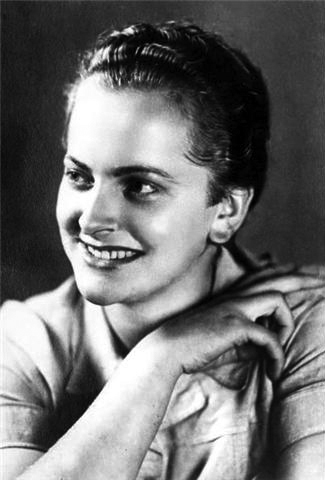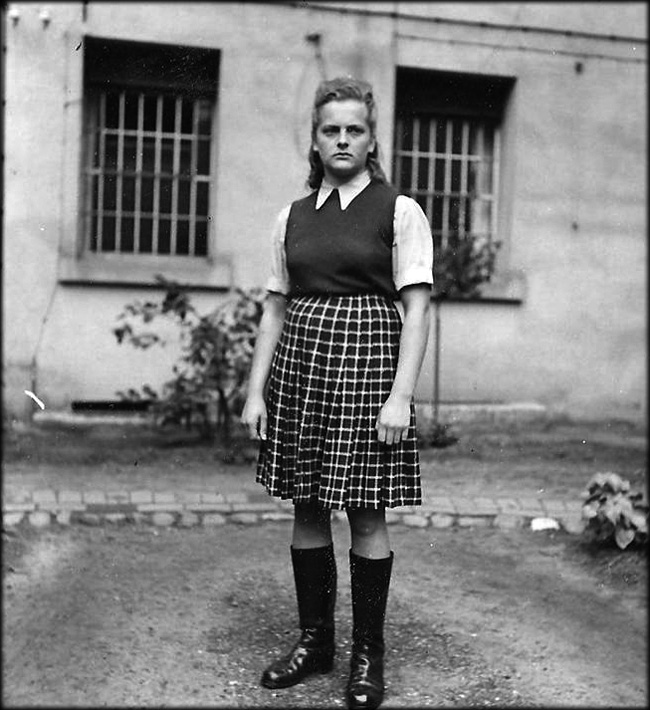Irma Grese (Irma Ida Ilse Grese)

Irma Grese was born to Berta Grese and Alfred Grese, a dairy worker. Irma was the third of five children (three girls and two boys). In 1936, her mother committed suicide by drinking hydrochloric acid after discovering that Alfred had had an affair with a local pub owner’s daughter. Alfred Grese is speculated to have joined the Nazi Party in 1937, and remarried in 1939. Irma Grese left school in 1938 at age fourteen, probably due to a combination of a poor scholastic aptitude, bullying by classmates, and a fanatical preoccupation with the League of German Girls (Bund Deutscher Mädel), a Nazi female youth organization, of which her father disapproved. Among other casual jobs, she worked as an assistant nurse in the sanatorium of the SS for two years and unsuccessfully tried to find an apprenticeship as a nurse. Irma Grese worked as a dairy helper and was single when she volunteered for service in a concentration camp. From mid-1942 she was an Aufseherin (female guard) at Ravensbrück and in March 1943 transferred to Auschwitz-Birkenau. In the second half of 1944, Grese was promoted to Rapportführerin, the second-highest rank open to female KZ-wardens. In this function, she participated in prisoner selections for the gas chambers. In early 1945, Grese accompanied a prisoner transport from Auschwitz to Ravensbrück. In March 1945, she went to Bergen-Belsen along with a large number of prisoners from Ravensbrück. Grese was captured by the British on 17 April 1945, together with other SS personnel who did not flee.
Irma Grese inspired virulent hatred in prisoner Olga Lengyel, who wrote in her memoir Five Chimneys that selections in the women’s camp were made by SS Aufseherin Elisabeth Hasse and Irma Grese. The latter was visibly pleased by the terror her presence inspired in the women at roll call. Grese had a penchant for selecting not only the sick and the weak but any woman who had retained vestiges of her former beauty. Lengyel said that Grese had several lovers among the SS in the camp, including Josef Mengele. After Grese forced the inmate surgeon at the infirmary into performing her illegal abortion, she disclosed that she planned a career in the movies after the war. Lengyel felt that Grese’s meticulous grooming, custom fitted clothes, and overuse of perfume were part of a deliberate act of sadism among the ragged women prisoners. Grese was among the 45 people accused of war crimes at the Belsen Trial. She was tried over the first period of the trials (17 September to 17 November 1945) and was represented by Major L. Cranfield.
The trials were conducted under British military law in Lüneburg, and the charges derived from the Geneva Convention of 1929 regarding the treatment of prisoners. The accusations against her centred on her ill-treatment and murder of those imprisoned at the camps. Survivors provided detailed testimony of murders, tortures, and other cruelties, especially towards women, in which Grese engaged during her years at Auschwitz and at Bergen-Belsen. They testified to acts of sadism, beatings and arbitrary shootings of prisoners, savaging of prisoners by her trained and allegedly half-starved dogs, and to her selecting prisoners for the gas chambers. Irma Grese was reported to have habitually worn heavy boots and carried a whip and a pistol. Witnesses testified that she took pleasure in using both physical and psychological methods to torture the camp’s inmates and enjoyed shooting prisoners in cold blood. They also claimed that she beat some women to death and whipped others using a plaited whip. During the trial, the press labelled Grese as “the Beautiful Beast” alongside Kramer (“the Beast of Belsen”). Although the charges against some of the other female wardens (a total of 16 were charged) were as serious as those against Grese, she was one of only three female guards to be sentenced to death. After a 53-day trial, Grese was sentenced to death by hanging.
Irma Grese and two other women, Johanna Bormann (mistakenly spelled Juana by the British) and Elisabeth Volkenrath, were convicted along with eight men for crimes committed at Auschwitz and Belsen and sentenced to death. As the verdicts were read, Grese was the only prisoner to remain defiant. Her subsequent appeal was rejected. On Thursday, 13 December 1945, in Hamelin Jail, Grese was led to the gallows. The women were executed singly by long-drop hanging and then the men in pairs.
Born
- October, 07, 1923
- Germany
- Wrechen, Free State of Mecklenburg-Strelitz
Died
- October, 07, 1923
- Hamelin, Germany
Cause of Death
- execution by hanging
Cemetery
- Am Wehl
- Hanover, Lower Saxony
- Germany



